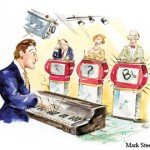Autism traits in absolute pitch musicians
Hello and a happy November to you all!
 Here in the UK November marks the start of ‘Mo-vember’, a really nice charity campaign to raise money and awareness into male health, specifically prostate cancer and testicular cancer. The idea is that men, Mo Bros, can take part by growing a moustache for the month and hopefully by getting some sponsorship along the way.
Here in the UK November marks the start of ‘Mo-vember’, a really nice charity campaign to raise money and awareness into male health, specifically prostate cancer and testicular cancer. The idea is that men, Mo Bros, can take part by growing a moustache for the month and hopefully by getting some sponsorship along the way.
Each Mo Bro must begin the 1st of Movember with a clean shaven face. For the entire month each Mo Bro must grow and groom a moustache.
Whilst I can’t take part in this excellent campaign I count myself as a Mo Sista, supporting beloved Mo Bros among my family and friends who are diving in. It is a bit of fun really but with a real great cause in mind so please spread the word if you can and help make Mo-vember a big success!
Right, on to the subject at hand; absolute pitch, musicians and autistic traits.
A new paper out recently in PLoS One (free access!) studied the prevalence of sub-clinical autistic traits in musicians who possess absolute pitch as compared to musicians who do not (like me) and nonmusicians. Why, you may ask?
 Absolute pitch is the ability to name a note correctly in the absence of an external reference. Just play one note and a person with AP should be able to say whether it was an A or an F, for example. This ability is thought to exist in about 1 in every 10,000 people although the prevalence may be higher in East Asian populations.
Absolute pitch is the ability to name a note correctly in the absence of an external reference. Just play one note and a person with AP should be able to say whether it was an A or an F, for example. This ability is thought to exist in about 1 in every 10,000 people although the prevalence may be higher in East Asian populations.
Research has so far identified early musical training and some genetic factors as predictive of AP. Those two factors can’t be the whole story however, as there are plenty of musicians who begin their training early but who show no reliable AP ability. The present paper, by Anders Dohn and colleagues, aimed to investigate a promising factor from within individual differences.
Why chose autism traits? AP is likely to be higher in individuals who have sensory and developmental difficulties, and one such predictor is autism spectrum disorder (ASD). Previous findings had suggested that pitch information may be encoded with increased specificity in these individuals – we have the beginnings of a theoretical link here.
ASD is a neurodevelopmental disorder but there is increasing recognition that aspects of ASD can be found at sub-clinical level in the normal population. The same is true in OCD, for example. ASD in the general population can be measured using the Autism-spectrum Quotient (AQ) questionnaire which measures social skills, communication, imagination, attention to detail and attention switching.
The present study used the AQ to determine whether or not musicians with AP show increased levels of sub-clinical autism traits compared to non-AP musicians and nonmusicians.
 Method: Questionnaires were taken by 16 APs, 18 non-AP musicians, and 16 nonmusicians, matched for age and preferred style of music, and in the case of the musicians for age of onset of musical training. The authors confirmed the presence or absence of AP using a simple pitch identification task, as is commonly used in the AP literature.
Method: Questionnaires were taken by 16 APs, 18 non-AP musicians, and 16 nonmusicians, matched for age and preferred style of music, and in the case of the musicians for age of onset of musical training. The authors confirmed the presence or absence of AP using a simple pitch identification task, as is commonly used in the AP literature.
Results: In line with the hypothesis the AP musicians showed higher AQ scores compared the other two groups, who did not differ from each other. There was also a significant correlation between performance on the AP test and score on the AQ test.
The AQ is composed of many factors of course, such as social and communicative inclination and ability as well as attention to detail and more. So which of these if any was individually more predicatively powerful?
The biggest difference between AP possessors and everyone else was not attention to detail, communication or social skills but rather imagination and attention switching; both were lower in the AP group.
This last finding was a little unexpected as previous findings have reported that AP possessors are more likely to have impairments in social behaviours (Brown et al. 2003). The authors point out that these results have not always been replicated successfully and more papers have supported a difference in areas associated with cognitive flexibility (i.e. attention switching).
Importantly all but one of the AP musicians had AQ scores that were well below the cut-off for potential diagnosis of high functioning autism, and that one individual was right on the border with no prima facie evidence to suggest the presence of the condition.
Overall, the researchers have challenged previous findings that AP musicians show lower social and communicative skills and instead suggest that a degree of cognitive inflexibility, expressed in lower imagination and attention switching ability, may be a more useful source of future investigations into the links between AP, autism traits and musicianship.
Brown WA, Cammuso K, Sachs H, Winklosky B, Mullane J, et al. (2003) Autism-related language, personality, and cognition in people with absolute pitch: results of a preliminary study. J Autism Dev Disord 33: 163–167. FIND THIS ARTICLE ONLINE
One Comment
Pingback: